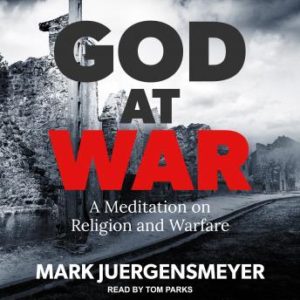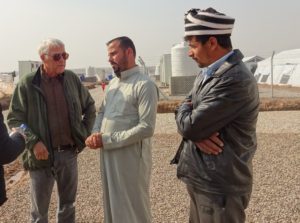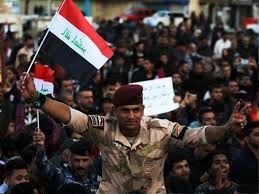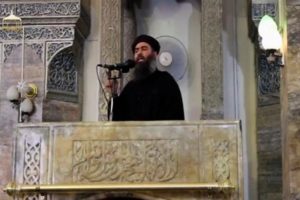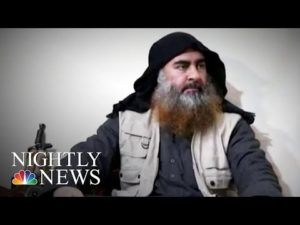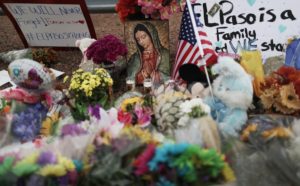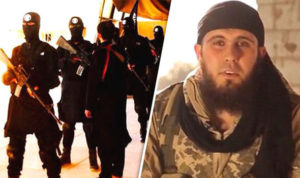My new book, God at War, which tries to understand what the concept of war is and how it is related to religion, is now available as a talking book from Audiobooks.com. You can hear a half hour for free on this website. https://www.audiobooks.com/audiobook/god-at-war-a-meditation-on-religion-and-warfare/436936
Covid vs Cultural Nationalism
The recent pictures in American media of angry and largely white male protestors, many with Trump’s MAGA hats, could have been taken several months ago. The target, however, is vastly different.
Just a couple of months ago the perceived global assault on American nationalism was economic—entangling trade alliances that were touted as taking away American jobs—or forms of cultural globalization aimed at undermining the American way of life.
The perception that there was a global cultural assault on nationalism was easy to imagine since the evidence of it was closely at hand. After all, waves of new immigrants from non-European countries entered the United States in recent decades, some illegally. They were easy to marginalize since they were different from white Euro-Americans, not only ethnically but in some cases by their religion. Worst of all were those who were Muslim.
But the new pictures of virtually the same angry white males with MAGA hats do not show them protesting against Muslims or Mexicans. They are protesting against a new global threat, virtually invisible ones, tiny virus cells. Covid-19 is the new global enemy, imagined to be aided by those scientists, health professionals and public leaders who appear to conspire with the virus to vex the ordinary lives of angry white males with MAGA hats. It is now covid-19 that is thought to be undermining the American way of life.
Covid-19 is a neologism created by shortening the phrase coronavirus disease 2019. Like SARS and the other previous coronaviruses it is an airborne respiratory virus that is highly contagious. Because it was likely first transmitted to humans from live animals in Wuhan, China, it has been possible to link the disease with foreign and sinister global forces out to undermine the American way of life. The conspiracy theories regarding its origins and spread are ubiquitous.
To a paranoid segment of the right-wing community in the US, these conspiracies were linked to globalization. The virus was the attempt of China, or the UN, or Bill Gates, or 5G technology—or some other sinister force—to scare Americans and deprive them of their liberty. Rather than blaming the government for its ineptitude in allowing the virus to spread rapidly, making the US by far the most infected nation on the planet, the blame was placed on fictional foes.
Perhaps the most frightening of the imagined falsehoods has been the notion that the disease is not real, but a hoax perpetrated by clever liberals to sedate the populace. Hence those who held to this fiction could cavalierly ignore any of the recommended restrictions, crowding together in public and thereby endangering everyone else. Doctors treating some covid-19 patients have had to contend with their arguments that they could not possibly have the disease since it was a hoax, and it didn’t actually exist.
These fears and the anger over having been constricted by restrictive pandemic regulations have brought hordes of gun-toting angry white men and women out on the streets in protest. Before American cities erupted in demonstrations against police brutality, led largely by young Blacks and progressive whites, these white MAGA hat-wearing protestors had the media’s attention. They will likely return in force, especially if new restrictions are adopted when the predictable second wave of virus infection occurs.
For the moment it seems that the global pandemic and its restrictions will continue to be at the center of American right-wing populist rage for some time to come. Rather than cultural nationalism this anger expresses a nationalism that is equally anti-global and defensive, a covid nationalism. The culture wars, and the animosity against immigrants, refugees, and Muslims has taken a back seat. The question is whether this covid nationalism is a turning point, whether it a brief deflection of attention, or whether it will be merged with cultural nationalism.
The question is not easy to answer since it largely depends on the future of the pandemic. The optimistic scenario is that the worst is over, that the rate of infections nationally will continue to decline, the economy will slowly reemerge and a vaccine will be found to be effective by the end of the year. In this scenario, the current fears may subside in the reemergence of normalization. And the old forms of cultural nationalism and its disdain against immigrants, minorities and Muslims may again surface. Or perhaps by then they will have been forgotten.
But the optimistic scenario is not the likely one. The possibility is real that there will be waves of new infections and with them new restrictions for at least a year or more to come. The greatly anticipated vaccine may be years off, and perhaps not discovered for decades. There is still no vaccine for AIDS, for example, though it has become a managed disease. Perhaps the same could be the case with covid-19. We could learn to live with it, though many of the restrictions would continue to be in place.
This means that resentment against the restrictions will continue. The conspiracy theories are likely to proliferate, and the sense that the luxurious American way of life is being corroded by sinister global forces may expand. Covid nationalism could be a major element of the continuing right-wing populism of the future.
But that does not mean that cultural nationalism will be forgotten. One can easily imagine conspiracy theories emerging—as indeed some already have—that blame immigrants, Muslims, liberals, foreign interference and global forces for the pandemic and its restrictive assault on familiar daily life. Thus the two forms of populism could forge an unhappy alliance.
At present covid nationalism—a populist protest against an imagined global intrusion of pandemic restrictions—is largely an American phenomenon. But like the virus itself, it could easily spread across borders, and become a feature of angry segments of the populace in Europe and other parts of the globe. There, too, it could merge with the existing anti-immigrant cultural nationalism of those regions. The global emergence of a covid-cultural nationalism could be the perfect storm of the future.
Why Has ISIS Revived?
Talking with Sunni Arab Refugees from ISIS near Mosul in 2019
In March 2019, the last bit of ISIS-controlled territory at Baghouz on the Syrian-Iraqi border fell to Kurdish fighting forces and their allies. Later that year its vaunted Caliph, Abu Bakr Al-Baghdadi, was killed in a US military assault in northeastern Syria. President Trump proudly proclaimed the end of ISIS.
Yet intelligence reports indicate that the movement is far from dead. In fact, it appears to be on the rise. In 2019, there were estimated to be 18,000 ISIS fighters remaining in guerrilla cadres. These sleeper cells and strike teams have conducted sniper attacks, ambushes, kidnappings and assassinations. They were particularly active in rural areas of the badly-policed borders between Syria and Iraq and between Iraqi Kurdistan and the rest of the country. Their targets have been government and foreign forces and anyone thought to be collaborating with them.
In 2019 the numbers of attacks increased over the year. In the first six months in Iraq alone there were almost 280 people killed in ISIS guerilla assaults, including erdUS contract security personnel. Among those killed was a Sunni Arab guard in Ramadi who went out at night to check up on his uncle’s farmland and was abducted and beheaded with a warning that a similar fate would await anyone who worked for the government.
The numbers of incidents this year are already up. The question is why? Why has ISIS returned so quickly, and why is it thriving?
The basic reason is that the conditions that encouraged so many Sunni Arabs to support ISIS have not changed. Their feelings of marginalization in Shi’a dominated Iraq and Alawite-dominated Syria have continued to make them second-class cities. Worse, some of their major cities, like Raqqa in Syria, and Mosul, Ramadi and Fallujah in Iraq, have been destroyed in the battles to end ISIS control. The Sunni Arabs who lived there often have nowhere to return.
As a result hundreds of thousands are languishing in refugee camps, where tentative hope has eroded into despair. There the ISIS message of Sunni Arab empowerment falls on receptive ears, especially among young men who find little opportunities for employment or education in the camps.
In the last several months, moreover, there are four other factors that have emerged that have propelled ISIS’ revival. All of them are related to policy decisions made by the U.S. President, often with little consultation with experts and advisors, and with little assessment of the potential consequences. These factors will have a long-range effect in strengthening the revival of ISIS:
Control in Syria diminished
When President Donald Trump announced that US forces would withdraw from the Kurdish regions of Northern Syria the shock waves were felt throughout the region. He had apparently made the decision on the spur of the moment during a telephone call with Turkey’s President Recep Tayyip Erdogan. Within a day Turkey was moving its troops into the area, pushing out the Kurds who lived there, planning to create a new buffer zone to relocate Syrian refugees and deny the Kurds a homeland from which they might influence Kurdish separatists in Turkey.
Since Kurdish forces had led the opposition against ISIS in the region, this meant that Kurdish troops were no longer able to patrol the region. The Russian-backed Syrian army was not adequate to the task. Hence the ISIS cadres had almost free reign to operate again within the formerly Kurdish-controlled areas of Syria.
Prisons left unguarded
Kurdish forces had maintained the detention centers and prisons in Northern Syria where some 10,000 former ISIS fighters were incarcerated. With the need for Kurdish troops to protect their own people in the face of the Turkish army that was trying to force an ethnic cleansing if Kurds in the region, many of the detention centers were suddenly seriously understaffed after the US decision to no longer project the Kurds. Prison breaks since then have released hundreds of seasoned ISIS militants back into society.
Control in Iraq diminished
Much of the containment of ISIS in Iraq was due to policies orchestrated by Iran through the Quds Force Commander, Qasem Soleimani. It was widely suspected that he had worked hand and glove with the US military in coordinating their offensive strategy against ISIS, despite his role in supporting anti-American groups throughout the Middle East. When he was killed in January 2020 through a US military strike ordered by President Trump, whatever coordination existed between the US and Iran was severed, and the specific strategies that were directed by Soleimani no longer had his skillful leadership to guide them.
Shi’a Extremists Emboldened
Perhaps a more important and long-lasting outcome of the assassination of Soleimani is its effect in emboldening the extremist activists within the Shi’a communities of Iran and Iraq. The moderate leaders had gambled their reputations on a peace agreement with the United States brokered in the administration of President Barack Obama, and when Trump reversed the US stand and pulled out of the deal, the hardliners appeared to have won. The killing of Soleimani was the last straw in the moderate approach. What this means is that extreme Shi’a militia now have greater liberty to prey on their ethnic rivals, Sunni Arabs and Kurds, who already are marginalized in the Shi’a dominated politics of Iraq and Syria. The beneficiary of this increased ethnic polarization is ISIS, which thrives on the suffering of Sunni Arabs, providing a voice for the dispossessed.
In a curious way, then, the effect of recent US actions in the region emboldens ISIS. By alienating Sunni Arabs, strengthening Iranian and Iraqi Shi’a hardliners, and withdrawing support from ISIS primary enemy, the Kurdish forces of Iraq and Syria, the US under President Trump has given ISIS a new lease on life.
US Intelligence figures of the number of ISIS related incidents in 2019 are cited in Eric Schmitt, Alissa Rubin, and Thomas Gibbons-Neff, “ISIS is Regaining Strength in Iraq and Syria,” The New York Times, August 19, 2019.
Fallout from the US-Iran War
When I heard about the assassination of Qassim Suleimani, the head of Iran’s Quds Force, by an American military missile strike at the Baghdad airport on January 2, I immediately thought of the repercussions. They are likely to be global, perhaps provoking another war. American military and government installations around the world may become targets.
The balance of power in the Middle East will be affected, and hardliners in Tehran will be strengthened. They have always been suspicious of America’s intentions, even during the short-lived nuclear peace agreement, and now they have new reason to build up Iran’s nuclear armaments.
But my immediate thoughts were not about this broader spectrum of dire consequences from a decision that appears to have been made quickly without extensive consultation by a President notorious for disastrous spur-of-the-moment foreign policy decisions. Rather, I thought about the affect within Iraq, where Suleimani was killed.
I have visited Iraq many times since the US invasion in 2003, and have developed friendships with colleagues especially in the Kurdistan region in the north. I fear that the rising US-Iran tensions will have an adverse effect on Iraq’s minorities—particularly the secularists, the Sunnis and the Kurds.
When I first went to Baghdad in 2004, shortly after the fall of Saddam Hussein, I talked with many academics, journalists and politicians who were hopeful about the rise of a secular democracy and new political parties organized around the interests of workers and farmers. Instead, politics in Iraq has devolved into ethnic and religious sectarian movements.
The spirit of secular democracy has persisted, however, and has been expressed most recently in the huge public rallies supported especially by young people protesting political corruption and the insidious ties to Iran. Now that Iran is under attack by the US, and the US has been using Iraqi territory as the base for which those attacks have been made, these protests have been drowned out in clamor for a martial patriotism to defend the sovereignty of Iraq. The power of the Iran-related Shi’a political parties in Iraq has been solidified.
The strengthening of Shi’a political groups is bad news for the two major ethnic minorities in Iraq, the Sunni Arabs in the Western region of the country and the Sunni Kurds in the north. My friends in the Kurdistan region have admired Americans and enjoyed the support of the United States over the years, beginning with an American-enforced no-fly zone over the Kurdistan region after the Gulf War. The Arabs in the rest of Iraq treated them as second-class citizens, and Kurds had few political allies in the region.
Though the ethnic community of Kurds comprise some 40 million people in eastern Turkey and the northern regions of Iran, Iraq, and Syria, they do not have their own nation. Moreover, their separatist aspirations are suspect in each of these four countries in which they have large populations. The United States supported them against Saddam, and then found in them useful allies in the fight against the Islamic State. Kurdish forces in Syria and Iraq were crucial in ending the territorial control of the Islamic State in 2018.
The Kurds assumed that the US would show its gratitude by giving them continued support, but alas the capricious decision by US President Trump to withdraw protective American troops from Syria in 2019 left them vulnerable to Turkish incursions into the Kurdish areas of Syria. The most recent anti-American mood in Iraq following the assassination of Suleimani will make the Kurdish pro-American stand even less acceptable to Baghdad. It also makes the Iraqi Kurds feel more vulnerable, since the US is increasingly not in a position to come to their aid, even if it was disposed to do so.
The Sunni Arabs in Iraq also will feel abandoned in the pro-Iranian mood following the Suleimani assassination. When I talked with Sunnis in refugee camps who have fled ISIS-controlled territory in western Iraq and Syria, many of them said they feared Shi’a control more than the harsh terrorist regime of the Islamic State.
The overwhelming number of ordinary Sunnis who supported ISIS during its heyday did so because they felt excluded from the Shi’a- dominated political life of the country, and marginalized when it came to receiving government jobs and benefits. Participation in the Islamic State was a form of Sunni empowerment.
When the ISIS regime was defeated in the main Sunni Arab cities—Ramadi, Fallujah, and Mosul—what was left behind were scenes of utter destruction. Very little government funding or other efforts have been made to restore the infrastructure and help in the rebuilding of these cities. Many of the residents languish in the enormous refugee camps erected in the Kurdistan countryside.
The Sunni dissatisfaction and fear of Shi’a militia has bolstered ISIS and led to an underground resurgence of the movement. The increased power of Shi’a politics and the unleashing of militant Shi’a groups such as the Sadr Brigade will only harden the Sunni antipathy towards Shi’a control and bolster the rejuvenation of the ISIS movement.
On the evening after the assassination of Suleimani, pronouncements from the White House and Pentagon focused on this one man, who was admittedly a mastermind of many treacherous operations throughout the Middle East. The implication was that in destroying Suleimani, a measure of peace would come to the region. Alas, however, the death of this one man may lead to a spiral of consequences, affecting most immediately Iraq’s minorities, the secularists, Sunnis and Kurds.
Why ISIS Needs a New Caliph
The old Caliph is dead. Long live the new Caliph!
This was the gist of an audio message uploaded onto the social media app, Telegram. It appeared scarcely five days after the October 26 US military raid near the Northern Syrian city of Idlib that ended in the suicide death of Abu Bakr al-Baghdadi, the notorious leader of the Islamic State (also known by the acronyms ISIS and ISIL).
Why so soon, and why a caliph?
Especially after the territorial defeat of the movement and the destruction of their headquarters in the Syrian city of Raqqa, Al-Baghdadi had become more of a figurehead of ISIS than its organizational leader. The movement continued on its own momentum through decentralized cells. It did not really need a new leader.
Yet a successor to al-Baghdadi was named, someone in the inner circles of the movement who adopted the pseudonym of Abu Ibrahim al-Hashemi al-Qurayshi. He was proclaimed not only as the organizational leader, but also as Caliph—the spiritual incarnation of Islamic tradition’s early leadership.
There are practical and ideological reasons why the surviving leaders acted so quickly. Not only did they want to affirm the leadership of the movement but also they wanted to assert the continuation the idea of the Caliph itself.
It shows that ISIS is still alive
This swift action by the surviving leaders showed that there were indeed surviving leaders. The very fact that they could convene a shura, a council of elders, is significant. It is not clear whether this was a physical meeting of the leaders or whether it was a consensus that came about through other means. But if the latter was the case, it would be interesting to know how they communicated, since most of the leadership has not used electronic devices for fear of being located, and presumably the leaders are scattered and in hiding.
The use of the term “mujahidin” (fighters) in conjunction with the term “shura” (council) is interesting, since there was a Mujahidin Shura Council comprised of different jihad Sunni Islamic groups, including al Qaeda in Iraq, that preceded the formation of ISIS. This could signal that there are several groups that are now involved in the resurgence of ISIS, including perhaps the jihadi groups that control the territory around Idlib, where al-Baghdadi was hiding out.
Though they were in opposition to ISIS previously, an accommodation among the groups would explain why they allowed the ISIS leaders free passage in the region and the ability to meet freely. It would also explain their involvement (if indeed this turns out to be the case) in the selection of a new leader.
There had been a second in line to Baghdadi who was waiting to take over. Abu Hassan al-Muhajir was Baghdadi’s spokesman and heir apparent in the eventuality of his death. Baghdadi wore a suicide belt at all times and was constantly on the move with the assumption that he was a marked man. Al-Muhajir’s succession lasted only a day, however, since he was killed by a US military strike the day after al-Baghdadi’s death on a road near the town of Jarablus in Aleppo province in the same general area of Syria where Baghdadi was hiding.
With the killing of al-Muhajir the ISIS council moved quickly to proclaim someone else as leader, and also to appoint a new second-in-line in case he was killed. The point was to assert that the movement was not dead, even if the leader was.
The very fact that the movement had the organizational ability to meet and agree on a new leader and to announce that fact to the world was impressive. It was meant to impress, and to bolster the confidence of its far-flung followers.
It gives assurance of continuing personal leadership
The death of a charismatic leader can spell the doom of a movement. Or it can bolster a movement, as was the case with the Israeli attack on Shekh Ahmed Yassin, leader of the Hamas movement in Palestine, after which the Hamas movement expanded its strength.
By quickly anointing a new leader, the movement broadcast to its followers that the charismatic authority continued. Fighters in the movement had previously been urged to pledge loyalty not just to the Islamic State but to the person of al-Baghdadi himself. In proclaiming a new Baghdadi, the leadership circle wanted to emphasize that this line of personal authority was being maintained.
For this reason it was critical to assert that the new leader, Abu Ibrahim al-Hashemi al-Qurayshi, was not just a competent leader, he was a Caliph, a spiritual authority. His credentials to be regarded that way are asserted in his newly-created name, al-Qurayshi. This implies that he is from the Qurayshi tribe, the Arab community that was dominant in Mecca at the time of the Prophet’s birth, and to which the Prophet himself is said to have been descended. Therefore the new Caliph is in the lineage of the Prophet’s family and has the spiritual background to be proclaimed as Caliph.
It gives credence to the idea of an Islamic State
Because Baghdadi’s successor is regarded not just as the ISIS leader but as Caliph, this appointment underlines the idea that he is the leader not just of a movement but of an Islamic State. Without a Caliph, it is not a Caliphate; it is just another jihadi movement.
What sets ISIS apart from al Qaeda, al Nusra, and other extremist Islamic movements is not just that ISIS adopts the radical salafi jihadi ideas in an even more extreme way than they do, but also that it is different: it is a Caliphate. That is, the movement proclaimed itself to be the incarnation of the early Islamic community. All of the extreme practices of the movement were justified by its interpretation of what the leaders thought were the rigid rules of early Islam.
Much of the appeal of the movement, especially to its far-flung followers around the world who connected with it on line through internet websites and Twitter, Telegram and other social media platforms, was that it was something new in the jihadi world; it was a Caliphate. It was the “real deal,” as some of its followers asserted. Without a Caliph, a Caliphate is just another movement.
For these reasons the surviving leaders had to act swiftly. They needed someone to represent the endurance not just of the movement, but of the Caliphate itself. Whether it will be accepted as such by its followers is yet to be seen.
ISIS After Baghdadi
ISIS will do just fine.
Shortly after the capture and apparent death of Abu Bakr al Baghdadi, Caliph of the Islamic State, was announced on television, commentators were quick to observe that this will probably not end the movement. They are right.
There are three reasons why this is the case. Based on my meetings with ISIS supporters and former militants in the movement earlier this year in the Kurdistan region of northern Iraq, I am convinced that his death will not deter the more ardent members of the movement.
Quite the contrary. It may accelerate the violence. Here are the reasons:
Baghdadi died a martyr
Despite the undignified crowing of the US President Donald Trump that Baghdadi went “whimpering” and “died like a dog,” the ISIS network will report this quite differently. The fact is that Baghdadi, when cornered, took his own life.
This is precisely what the ISIS militants are taught to do. They are expected to die gloriously in battle, either by carrying out an attack mission, or if caught, to take their own life.
Baghdadi ignited the suicide vest that he has kept on his body for years. Some say that he even slept with it on. He fully expected that the time would come when the choice would be capture or death by suicide, and he was prepared to die.
For this reason, he will instantly be regarded as a martyr within the movement. For those who had complained about the ISIS leadership and felt that Baghdadi was only trying to protect himself, he will be vindicated. He died a martyr’s death.
Baghdadi was not essential to the leadership
Unlike al Qaeda, the organizational structure of ISIS has always been fairly decentralized. Decision making power is given to decentralized units of the movement. Baghdadi was paranoid about digital communication being intecepted and never used a cell phone or any electronic device. Communications were by human courier, which meant that they were slow and infrequent, thus requiring a decentralized form of organization.
On a global scale, where groups from Nigeria to the Philippines are claiming allegiance to ISIS, there is virtually no direction from ISIS central command. So the absence of a central leader will scarcely be noticed.
Moreover, since the fall of Raqqa there has been no obvious central command. The movement has been fending for itself, and the sporadic acts of terrorism are planned and conducted by local cells and individual actors.
There is no reason to think that any of these local operations will be curtailed by Baghdadi’s death. In fact the glorification of him as a martyr might be a new rallying point for members of the movement.
When I talked with former ISIS militants who were convicted and in prison in Iraq, some told me that they had already been disillusioned with the ISIS leadership. They thought it was incompetent and self serving. They still believed strongly in the idea of a caliphate, however, and would fight for one if they were convinced the leadership was more deserving.
A new leader of ISIS will soon be anointed. He may take on the mantle of caliph. Whether or not he does, he will have the opportunity to provide new energy and momentum to the movement. So Baghdadi’s death might become a stimulus to ISIS revival.
ISIS enemies are diminishing
The death of Baghdadi might give the illusion that the movement itself is dead. This would be huge mistake, since it might deflect attention away from surveillance and engagement with the movement.
Already the capricious decision to remove US troops from northern Syria and cease air support for the region has been a catastrophe for the Syrian Kurds. These are precisely the fighters who have defeated ISIS in the region, with US assistance (not the other way around).
It is bittersweet irony that the capture of Baghdadi was once again a victory for the Syrian Kurds. Immediately after the attack their leader sent out a tweet to members of the Kurdish organization congratulating them on their achievement.
In an embarrassing acknowledgement, US President Trump scarcely mentioned the importance of the Kurdish troops in the operation. He thanked Russia, Syria, and Turkey, even though they had little to do with the operation—the Russian defense ministry even denied providing air space permission. Trump then also said that the Kurdish troops “helped,” whereas in fact they made the raid possible.
The killing of Baghdadi might also be the last major act of collaboration between US military and Kurdish forces. If so, it leaves a huge swath of territory in northern Syria vulnerable to the rise of ISIS.
The location where Baghdadi was discovered is an area controlled by jihadi groups that have not been ISIS-related in the past. There is speculation that by allowing Baghdadi safe harbor there, the jihadi movements were joining forces. If so, it is a huge mistake to withdraw support from the one group shown to be effective in fighting them—the Kurdish forces.
Years ago the Israeli military made a huge mistake in thinking that if they killed the leader of the movement, Sheik Ahmed Yassin, they would kill the movement itself. Quite the contrary, the martyrdom of Yassin gave new life to the movement, and today Hamas still controls the region of Gaza as a result. Al Qaeda has survived after bin Ladin, and it is almost certain that ISIS will survive the death of Baghdadi as well.
ISIS Will Return
ISIS will return. The reason I feel confident in saying this is because I have talked with them. Earlier this year I was in the Kurdistan region of Northern Iraq where I met with ISIS-suspected detainees in the huge Hassan Sham refugee camp near Mosul, and with captured jihadi fighters in a prison near Sulaimaniya.
“We will return,” one of the former ISIS militants told me. He said that he was disenchanted with the leaders of the movement, whom he blamed for its military defeat. But he still believed in the idea of a caliphate and the extreme ideology of the ISIS apocalyptic world view. He would rejoin it in a minute, he told me, if he had the opportunity.
The opportunity may be coming sooner than he or any of us had thought. With the precipitous US military withdrawal from Northern Syria, the chances of ISIS regrouping military has expanded exponentially. The Kurdish forces that had defeated them, imprisoning the militants and putting their families in detention camps, have been abandoned by the capricious decision of US President Donald Trump to summarily withdraw from the region. This allows for Turkish forces to move in, and to attack by air strikes without fear of US reprisals. Although the Kurds have quickly made alliance with the Russian-backed Syrian army it is unlikely that they will be able to provide the level of protection that the US military had supplied.
This means that the ISIS movement has a new lease of life. More than 800 former ISIS fighters escaped from the Ayn Issa camp in Northern Syria five days after the US troop withdrawal and the Turkish attacks began. About 10,000 ISIS fighters remain in camps in Kurdish-controlled areas of northern Syria, and the chances are good that many of them will escape as well.
Added to this problem is the matter of sleeper cells. These are groups of ISIS fighters who were not captured but have gone into hiding and are awaiting the opportunity to come out of the shadows and fight again. A number of new bombings and attacks in northern Syria indicate that many of these sleeper cells are now operating more openly. Coordination among them could lead to serious military operations and the possibility of retaking territory in ISIS’ name.
Across the border in Iraq, leaders of the Kurdish controlled region are nervous. When I was there earlier in the year, I was told that members of ISIS were still everywhere, including among refugees in camps, quietly organizing and waiting for the opportunity to rise up more openly. The signals from Syria indicate that that time may have come.
In an odd way, the US forces that helped to defeat ISIS have now provided the opportunity for its return.
El Paso Shooter’s Global Ties
A version of this article is posted on Global-e, Tuesday, August 13.
The manifesto of Patrick Wood Crusius, the 21 year old man responsible for a blood bath killing 22 innocent shoppers in a WalMart store in El Paso Texas on August 3, begins with praises for another attacker in a location far from Texas– in Christchurch, New Zealand. The Christchurch shooter, Brenton Tarrant, killed 51 worshippers at two mosques on March 15 and he, in turn, had praised another attacker at a location that was far from both Texas and New Zealand–in Oslo, Norway. There, Anders Breivik killed 77 youngsters on July 22, 2011, at a summer camp for a political party supporting multiculturalism.
All three of these killers left manifestos. These documents were remarkably similar in that they presented themselves not as killers and terrorists, but as soldiers in an honorable battle. The purpose of the struggle was in each case basically the same: protecting the purity of White European culture. In the case of Breivik and Tarrant it was specifically a Christian culture. Breivik imagined himself to be reenacting the defense of Vienna against the Muslim army. Tarrant also thought of himself as a warrior for Christendom. Written in white on the black gun stocks of his weapons were the names of significant battles in European history in which Muslim forces had been repelled. Though the El Paso shooter, Patrick Crusius, did not refer to religion in his manifesto, he did cite the defense of European culture and ethnic purity as one of his motives. In his own way he was a warrior for European Christendom as well.
The global diversity of these instances of religious and ethnic xenophobic extremism gives a hint of why they are rising now. They are global, and the phenomenon of globalization may be part of the problem.
Therein lies a paradox. Globalization is marked by a rapid mobility of peoples, mass migrations, the proliferation of diaspora cultures, and a transnational sense of community provided by internet relationships. Yet despite these features, xenophobic ethno-religious nationalism persists. In fact it seems to flourish in a global world. Religious and ethnic affiliations, while providing a connection to transnational networks, also offers resources for shoring up local identities. Why have limited loyalties and parochial new forms of ethno-religious nationalism surfaced in todays’ sea of post-nationality?
It seems an anomaly. History is poised on the brink of an era of globalization, hardly the time for new nationalist aspirations to emerge. In fact, some observers have cited the appearance of ethnic and religious nationalism in such areas as the former Yugoslavia and the former Soviet Union, Algeria and the Middle East, South Asia, Japan, and among right-wing movements in Europe and the United States as evidence that globalization has not reached all quarters of the globe.
But is this really the case? It may be possible to see these quests for local identities and new nationalisms not as anomalies in the homogeneity of globalization, but as further examples of its impact. In many cases the new ethnic and religious movements are direct reactions to globalization—a fear of the “new world order,” as some patriot movements in the United States have put it. The El Paso killer’s manifesto stated that the tide of Hispanic immigrants would be a sea change in American culture and politics. His was angst over the loss of identity and privilege in a world that is rapidly become multicultural.
But many of these movements are also responses to a perceived failure in secular nationalism. Though the European Enlightenment touted secular nationalism as the most just and progressive form of political organization for the modern world, in many parts of the world this vision is an empty promise. They despair over the insufficiencies of what is often touted as the world’s global political standard, the secular constructs of nationalism that are found not only in Europe and the United States but remain in many parts of the former Third World as vestiges of European colonialism. The El Paso killer’s manifesto railed against the corporate state and the failure of democracy. An exasperated follower of ISIS in Iraq said to me, “what have we gained from being a secular state?”
The old European-version of secular nationalism is under siege precisely at a time when the structure of the nation-state around the world has been weakened by globalization. Its vulnerability has been the occasion for new ethno-religious politics to step into the breach and shore up national identities and purposes in their own distinctive ways.
Some forms of ethno-religious politics are global, some are virulently anti-global, and yet others are content with the attempt to create their own ethno-religious nation-states. The White nationalist killers in El Paso, Christchurch, and Oslo are not alone. They and the many other activists in recent decades, in virtually every religious tradition, who have expressed a strident ethno-religious nationalism have challenged the moral authority of the secular state. They are anti-national globalists in their own way, standing in uneasy relationship with the globalizing economic and cultural forces of the 21st century world.
The 3 T’s of ISIS Recruitment
A former ISIS fighter told me how they wooed and recruited new fighters into the ranks of the Islamic State movement. I had a long conversation with the tall 29-year old Mohammad after he had been captured and was held in a prison in northern Iraq, and though he was still committed to the Caliphate and the apocalyptic jihadi world view of al Qaeda and ISIS, he was now able to reflect on his role in the movement. Among other things, he explained the initiation process–how they would infiltrate into a group of young men and slowly bring them to the jihadi cause.
It all boiled down to three T’s, he told me. In Arabic, the three words were تمسكن tammaskan, تمكن tammakan, and تفرعن tafar’aan. Each of these described a stage in the developing involvement of a young man targeted for recruitment into the jihadi movement.
The first T, tammaskan, which means to “stick by” someone, to embrace him in an intimate friendship. Mohammad explained that they would usually target a younger man who might be flattered by the friendship of an older more active man. The target would usually be someone in his late teens who was searching for meaning and a role in life. The ISIS recruit would befriend him and only occasionally discuss religious and political matters.
The second T, tammakan, “control,” referred to the next stage of recruitment. After a period of friendship the older man would exert more leadership and take an authoritative relationship to the younger man. He would become more directive in telling him where he had gone wrong in life and what to do about it. The conversation about religion and politics would become explicit, with the clear implication that the young man should learn from these pronouncements.
The third T, tafar’aan, means “act like a Pharoah,” or enslaving. After it had become clear that the young man was responding to the authoritative relationship with the ISIS recruiter, he was ready to be made captive to the ISIS cause. In some cases there would be a kind of initiation, a recognition that the young man was now ready to take on a role in an important cause and become a servant in a secret circle of friendship.
Mohammad himself had gone through these stages of recruitment when he was a fifteen year old teenager in the town of Mosul. It was several years after the US invasion and occupation of Iraq which had severe repercussions on his Arab Sunni family. They had prospered under Saddam’s regime and now the family was poor and marginalized. For young Mohammad, the friendship and the cause of the jihadi movement then known as al Qaeda in Iraq was something of a salvation.
Some years later when al Qaeda in Iraq became the Islamic State, Mohammad saw new generations of young fighters being recruited into the ranks in the same way that he had been wooed and inspired. The recruiters invariably followed the three T’s. They befriended, controlled, and ultimately enslaved them.
My thanks to Shahid Burhan Hadi for his arrangements and translation assistance when I was in Iraq in March 2019, and to the support of the Resolving Jihadist Conflicts Project of Uppsala University, directed by Isak Svensson.
The ISIS Fighter Still at War
The fighter pictured is for illustration only; he is not the one I interviewed, since the prison did not allow photographs.
“This war is not over,” the tall, bearded Iraqi old me, his voice quivering with rage. Mohammad was a fighter for the Islamic State, and even though he was only 29 years old when I talked with him in prison in Northern Iraq, he had been a fighter with ISIS and its predecessor, al Qaeda in Iraq, since 2005. In his mind he was still was at war.
Though he said the war was over, in fact it was over for him in reality since he was serving what would be a long prison sentence, perhaps for a life time. The war was also over in another sense, in that he had left the militant organization in disgust over its corruption even before he was arrested and the movement was militarily defeated.
His story provides an interesting case study on how an extremist movement like this can end as a militant threat, even though its ideology of warfare persists. But to understand how this came about—how Mohammad came to reject the movement that enshrined the ideology of cosmic war to which he remains dedicated—we have to look at how he got involved in it in the first place.
Mohammad even at age 29 still has a soft round face framed in a traditional Muslim beard. He is a tall guy, physically large and somewhat intimidating when he stands up to make a point. The warden had allowed us to meet in a private conference room so we would not be disturbed. I was alone with my Arabic translator and Mohammad. And although the warden thought that I would be safe, there were moments in the conversation that were a bit frightening.
The conversation began quietly as Mohammad told me how he gotten involved in the movement. He was raised in Mosul in a Sunni Arab family that had prospered under the Saddam regime. Some of his relatives were in Saddam’s army. The family’s fortunes and its political connections came crashing down when the US invaded Iraq in 2003 and Saddam was deposed.
The first stage of Mohammad’s militancy was one of identity politics. As a Sunni Arab he was incensed that the US occupation not only deprived Saddam loyalists of their occupations but also raised Shi’a politicians to positions of prominence where they could systematically exclude Arab Sunnis from meaningful participation in the government or the receipt of lucrative government contracts. Though a young teenager at the time, Mohammad life was deeply disrupted and his anger turned towards militancy.
When Abu Musab al Zarqawi formed al Qaeda in Iraq, Mohammad saw it as a way of empowering Sunni Arabs. In 2005, when he was scarcely fifteen years old, he joined the movement and became a fighter for AQI. All his friends were doing it, he said, and the leaders that he met with at the time were inspiring. He saw it as a way of redeeming his community and proving his manhood. He saw the movement as a liberating force for Iraq, he said, adding that “Iraq had become a colony of Iran.”
He would not tell me what he actually did in the movement, though he said that “everyone was equal” and they rotated such tasks as transporting weapons, helping with communications, setting improvised explosive devices, and fighting in teams. Within a year, however, he was caught, arrested, and sent to prison for two years, from 2006-2008.
Those two years in prison comprised a formative phase in Mohammad’s radicalization. He described the prison as “jihad university,” since senior members of the movement were able to indoctrinate young recruits like Mohammad into the jihadi ideology. “We loved going to prison,” he told me, “it was just like going to school.” Classes were organized into different aspects of textual, historical, and theological studies. It was there that Mohammad embraced the anti-Shi’a, anti-Western apocalyptic Muslim extremism that later characterized the Islamic State. This, then, was the second stage of Mohammad’s radicalization, a religiously ideological stage.
When Mohammad told me what he believed, however, it was only the basics; it clear that whatever teachings he learned in prison he was not currently able to articulate the finer points of theology. The principles seemed to boil down to three main points: opposition to the forces that were resistant to true Islam, an opposition that included especially Shi’a, moderate Muslims, and Jews and Americans (whom he called Zionists and Crusaders), and belief in the coming Caliphate.
This was the point in the conversation where he became quite agitated. He stood up and thundered about the injustice done by these three groups of people—Shi’a politicians, moderate Muslim officials, and the American military. He said they could not be redeemed, and implied that the only recourse for them was death, looking at me sternly.
I nervously looked around the room at anything that might be used as a weapon in the event that he decided to carry out this sentence on an American professor in his presence. I realized that the pen in my hand that I was using to take notes could be used to stab me in the neck, so I quietly slipped it into my pocket.
Sensing my discomfort, Mohammad sat down, and his voice calmed. He could tolerate Shi’a and Americans, he said, when he was not in the Caliphate. He had Shi’a friends when he was younger, he said, and they were good friends at that, but they were not anti-Sunni the way that the Baghdad Shi’a seemed to be. He also said that some Americans could be decent people, a statement that I inferred could apply to me, which gave me some relief.
But when one is in the reign of the Caliphate, he said, everything has to change. In order to fulfill history, there has to be a total cleansing. Using language that appeared to legitimate the actions of the Islamic State when it was in power, Mohammad said that in the Caliphate no Shi’a or non-Muslim foreigners should be allowed, nor should moderate Muslims be tolerated. Christians could purchase their release, he said, but everyone else would have to be annihilated. “They have to be killed” he said, coolly. Even your old Shi’a friend, I asked him? “Yes,” he said quietly, adding that “all who are against us have to go.”
After prison he quietly became reengaged with the movement, slipping under cover so he would not be identified by the Iraqi police. The era of ISIS was exhilarating for him, he said, though he would not admit to being formally a part of the organization. He was a “known person” within the movement, he said, and people came to him for advice and counsel.
He did not volunteer any information about his specific role within the movement or acts that he may have committed. I assumed that he did not want to say anything that might complicate his prison sentence or contradict what he might have said in court when he was convicted. Moreover, the specifics of his role and activities were not my main interest. What I wanted to know were the basics: why he got involved and why he left.
His conversation implied that he played a leadership role, and that he got into disputes with others in leadership positions within the movement. At one point, he said, there was violent infighting, and during the ensuing struggle he was shot in the stomach by another member of the movement. Mohammad lifted up his shirt to show me the scars on his torso which were indeed severe.
That was the point in which he lost all faith in the leadership, Mohammad said. He became disillusioned with the organization and its leaders. He continued to admire some of the main figures, such as Abu Bakr al Baghdadi, who proclaimed himself the caliph, and Abu Mohammad al Adnani, who before he was killed in 2016 was the leading voice of ISIS and its chief spokesman. He had no use for Ayman al Zawahiri, the successor to Osama bin Laden as head of al Qaeda, since Zawahiri did not approve of the attacks on Shi’a. Mohammad regarded Iraq’s Shi’a leadership as being a terrorist organization, more dangerous, he said, than ISIS or al Qaeda.
So he respected some if not all of the well-known jihadi leaders. But on the lower levels, there were often squabbles and infighting. Many of these lower level leaders, Mohammad said bitterly, were just in it for the money and the power. Others used the ability to kill and punish as a revenge against people that they did not like.
What Mohammad told me confirmed much of what I have learned about how militant movements like this come to an end. The ideology does not change—and in fact, there is no point in counterterrorism measures that waste their time trying to convince militants of their theological or ideological errors and trying to change their minds. What makes them quit the movement in many cases is a collapse of authority within the movement itself, or the realization that their militant tactics were not working. Mohammad understood the legitimacy of killing enemies of true Islam, he said, but this power was increasingly abused. Ultimately the followers of the movement were turning on one another.
So he left. For a time he had to go undercover to protect himself against both the Iraqi police and his own former comrades in the movement. Eventually, when he was in an area outside the movement’s control, he was spotted by an Iraqi police informant and arrested. Mohammad still does not know whether that was a coincidence or whether he had been betrayed by someone in the movement.
Because he was a “known person” within the movement, as Mohammad described himself, there was a police dossier about his alleged activities which was used against him in his trial. Mohammad said that he did not cooperate with the judicial proceedings since he assumed that they had already determined in advance that he was guilty and that he would be serving a long prison sentence, if not a death sentence.
It turned out to be a prison sentence. He did not reveal the number of years, but implied that it was lengthy, perhaps a life sentence. The warden has kept him isolated away from other convicted members of al Qaeda and ISIS for his own protection, since he is regarded as a turncoat against the movement. His wife is allowed to visit him during regular visiting hours, he said. And he had hopes that some day he would be released.
I asked him what he would do if he was ever able to leave the prison? He would rejoin his wife and family, he said, and get some sort of job, perhaps in construction or auto mechanics. He would not take up arms and join the movement again, he said, even in guerrilla warfare. “We did that,” he said, asking “and what did that accomplish?” Fighting has only destroyed the movement he said, implying that it was destroyed both from outside and from within.
I wondered whether the idea of a great cosmic war would continue to loom so large in his imagination if the social and political situation was different—if, for instance, the government in Baghdad would welcome the Sunni Arab community as equal citizens? I wondered if the Iraq government would ever empower the Sunni tribal leaders in the way that led to the success of the Awakening movement against the earlier moment of al Qaeda activism in Iraq from 2006 to 2011. Without the sense of Sunni Arab outrage would the apocalyptic ideology of ISIS still be a motivating force?
At present, however, the governments of Iraq and Syria have not changed their suspicions about Sunni Arabs, and Mohammad has not abandoned the great image of cosmic warfare between the forces of evil and of true Islam in which the Shi’a politicians are the enemy. He believes that there will be a time when the Caliphate will rise again, and he is convinced that there will be righteous struggle in order to implement it. He will be ready to fight then, and he looks forward sometime to being a true soldier for that sacred cause.
But not now, he said. “Now is not the time.”
My thanks to Shahid Burhan Hadi for his arrangements and translation assistance when I was in Iraq in March 2019, and to the support of the Resolving Jihadist Conflicts Project of Uppsala University, directed by Isak Svensson.

